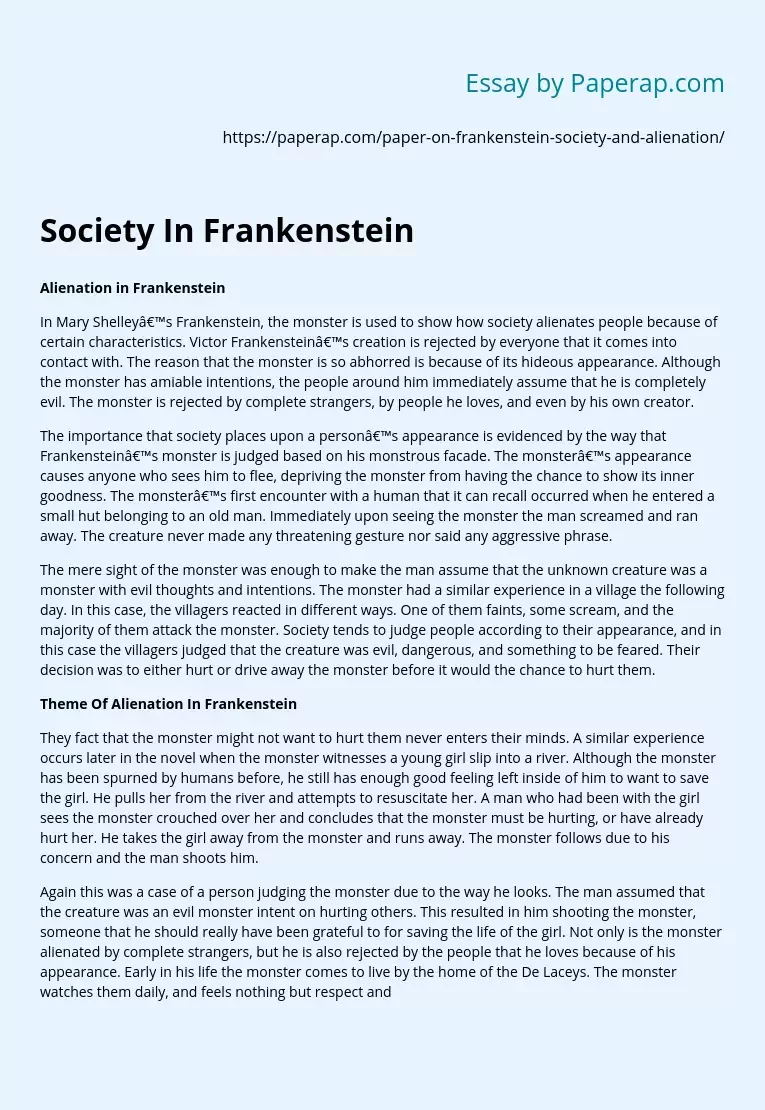Theme Of Alienation In Frankenstein Society
In Mary Shelley’s Frankenstein, the monster is used to show how society alienates people because of certain characteristics. Victor Frankenstein’s creation is rejected by everyone that it comes into contact with. The reason that the monster is so abhorred is because of its hideous appearance. Although the monster has amiable intentions, the people around him immediately assume that he is completely evil. The monster is rejected by complete strangers, by people he loves, and even by his own creator.
The importance that society places upon a person’s appearance is evidenced by the way that Frankenstein’s monster is judged based on his monstrous facade. The monster’s appearance causes anyone who sees him to flee, depriving the monster from having the chance to show its inner goodness. The monster’s first encounter with a human that it can recall occurred when he entered a small hut belonging to an old man. Immediately upon seeing the monster the man screamed and ran away.
The creature never made any threatening gesture nor said any aggressive phrase.
The mere sight of the monster was enough to make the man assume that the unknown creature was a monster with evil thoughts and intentions. The monster had a similar experience in a village the following day. In this case, the villagers reacted in different ways. One of them faints, some scream, and the majority of them attack the monster. Society tends to judge people according to their appearance, and in this case the villagers judged that the creature was evil, dangerous, and something to be feared.
Their decision was to either hurt or drive away the monster before it would the chance to hurt them.
They fact that the monster might not want to hurt them never enters their minds. A similar experience occurs later in the novel when the monster witnesses a young girl slip into a river. Although the monster has been spurned by humans before, he still has enough good feeling left inside of him to want to save the girl. He pulls her from the river and attempts to resuscitate her. A man who had been with the girl sees the monster crouched over her and concludes that the monster must be hurting, or have already hurt her. He takes the girl away from the monster and runs away. The monster follows due to his concern and the man shoots him.
Again this was a case of a person judging the monster due to the way he looks. The man assumed that the creature was an evil monster intent on hurting others. This resulted in him shooting the monster, someone that he should really have been grateful to for saving the life of the girl. Not only is the monster alienated by complete strangers, but he is also rejected by the people that he loves because of his appearance. Early in his life the monster comes to live by the home of the De Laceys. The monster watches them daily, and feels nothing but respect and admiration for them.
He looks for ways to ease their suffering. When he discovers that eating their food distresses them, he stops at once. He observes Felix leaving the cottage and returning later with wood and decides to chop wood for the cottagers at night in order to make Felix’s life easier. The monster spends months preparing for the day when he will finally be able to talk to the family, his happiness dependent upon the outcome. He hopes that he will be able to persuade them to see past his deformity using the eloquence that he has developed while watching them. The monster first attempts to talk to the old man.
This person is the only one who ever gives the monster the chance to talk without immediately judging him. The thing that sets the man apart from the others is the fact that he is blind. Although the monster has a breakthrough with the old man, when the rest of the De Laceys return and see the monster they react the same way that everyone else has. Felix sees the monster by his father and assumes that he is trying to hurt him. In response, he attacks the monster. The family is so scared of the monster that they leave their home, at a great financial loss.
They hate the creature that had nothing but warm feelings for them, thereby helping to turn him into the monster that they had assumed he was. Victor Frankenstein also rejects the monster and is disgusted by his appearance. Although Frankenstein constructed the monster and therefore had control over the way he looked, he creates something that he despises. It seems that Frankenstein hates the monster because it is unnatural, a creature that is different to everything that has ever existed. Victor also judges the monster by his appearance.
He believes that he has brought some great evil upon the earth. He doesn’t take the time to learn the monster’s true nature. He abandons his creation, rejecting his responsibilities as a creator because of the disgust he feels. Society continually alienates the monster because he is hideous. Beauty is associated with goodness, while ugliness is coupled with evil. Due to the cruel actions of the people who judge him, the creature who is initially good is gradually turned into the evil monster that society automatically assumes he is.
Theme Of Alienation In Frankenstein Society. (2019, Dec 05). Retrieved from https://paperap.com/paper-on-frankenstein-society-and-alienation/

